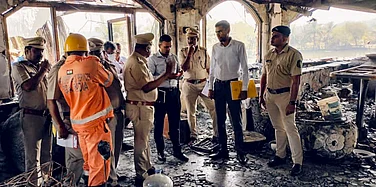For once, no one—not even the Opposition—is calling it ‘starvation deaths’. A week after three members of an adivasi family died after eating a cake made of mango kernel gruel at Mainapadar village in Jharigaon block of Odisha’s Nabarangpur district, the worst that former Nabarangpur MP Pradeep Majhi could accuse the Naveen Patnaik government of was “failure to ensure development”.
Four members of Arjun Santa’s family started vomiting on the night of August 20. His wife Sudhamani (30), sister Namita (15) and sister-in-law Pramila (28) died within hours of each other, while his six-year-old son Prakash survived what Nabarangpur chief district medical officer Sivarani Mishra called a case of ‘food poisoning’. Arjun and his brother were not at home when the rest of the family ate the mango kernel preparation.
The deaths brought back memories of the dying of 24 people at Kashipur in neighbouring Rayagada district in 2001 after having mango kernel and another two deaths in the same area in 2016, all of which were attributed to hunger. But it became clear soon that the deaths at Mainapadar were not a result of starvation.
“Arjun has 6.5 acres of land and earned Rs 3 lakh from maize cultivation last year,” says Nabarangpur collector Ajit Mishra. “This year too, he is expecting a bumper crop. He owns a tractor and a bike. We found he has about 60 kg of rice stored in his house, including the 20 kg he procured on his NFSA (National Food Security Act) card the previous week.”
But if Arjun is so well-off, one wonders how he became a beneficiary under the Centre’s flagship food security scheme. And why did his family members eat mango kernel when they had so much rice? “Mango kernel gruel is an integral part of the food habits of adivasis in the area,” says Jharigaon-based activist Parama Panda, who visited the family after the deaths. “They dry the kernel in summer, powder it and store it to be consumed during the monsoons when they are unable to go into the forests to fetch various roots and vegetables. It is a nutritious and tasty delicacy. But if the gruel is kept for days together, it develops fungus, which often proves deadly. The deaths in the Santa family have more to do with lack of awareness about hygiene than starvation.”
Absence of timely medical attention also played its part. The victims could have been saved had they been rushed to the hospital when they developed tell-tale symptoms of food poisoning. But there was a delay of around six hours, which exacerbated the problem, Mishra points out. He has a point—Prakash, who survived, had been shifted to the Shaheed Laxman Nayak Medical College in Koraput.
Admitting that the food had turned stale, Arjun says, “When we returned home on Monday night, we saw the mango kernel paste had turned black. Namita died late in the night, and we rushed Sudhamani, Pramila and Prakash to the Jharigaon primary health centre in the morning, from where they were referred to the district hospital. Sudhamani died on the way to Nabarangpur. Pramila and Prakash were then referred to the medical college in Koraput. That’s where Pramila succumbed.”
Lack of access to medical facilities combined with one of the lowest literacy rates in the state allows quacks to prosper. After the Mainapadar deaths, the collector says the district administration has launched an awareness campaign on the perils of eating fermented mango kernel. There’s nothing novel about it, though—such campaigns have been organised from time to time, without much success, in what is known as the KBK (Kalahandi, Bolangir, Koraput) region, one of the most impoverished in the country.


























